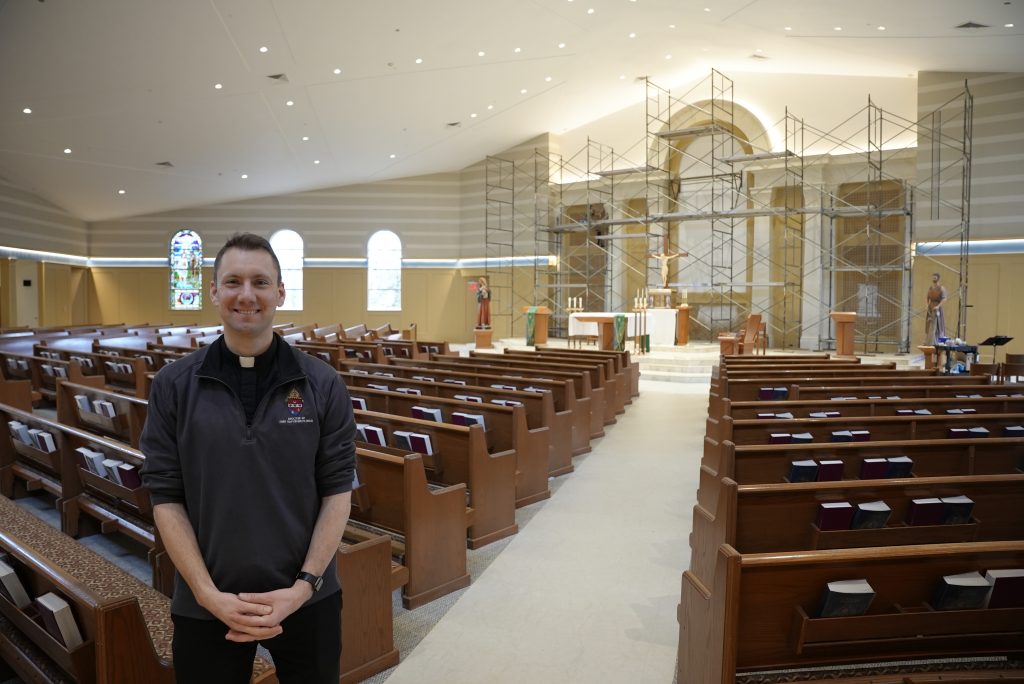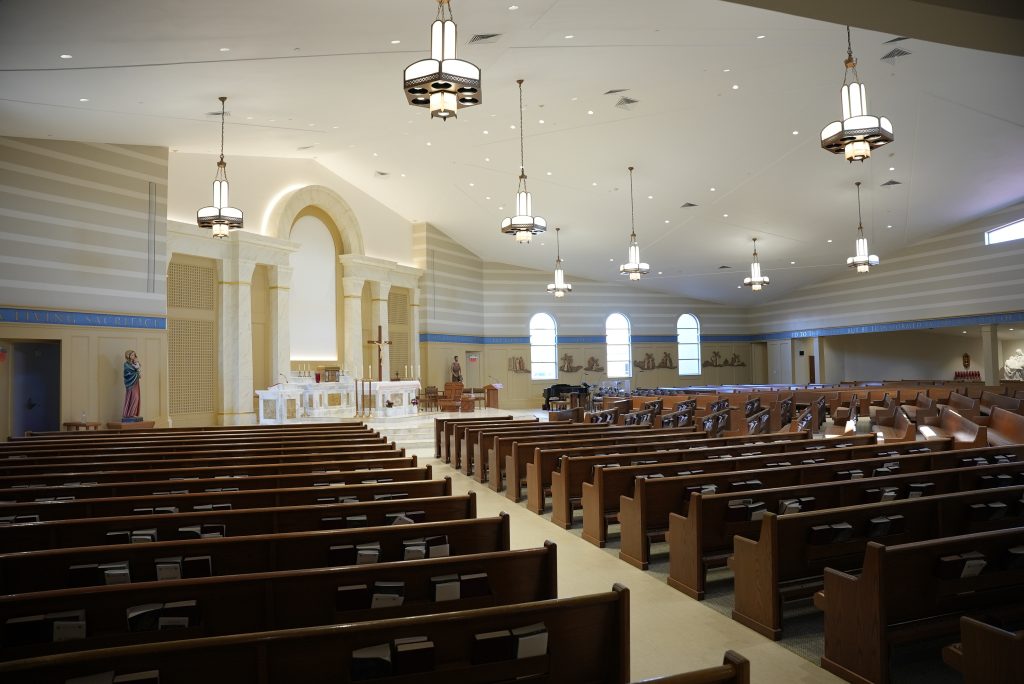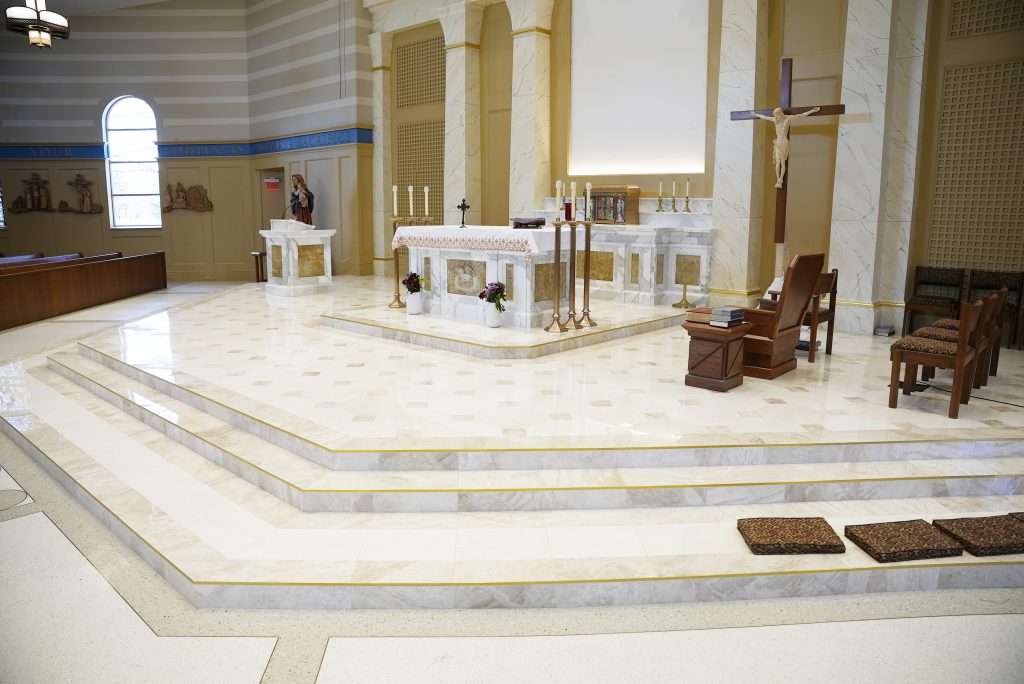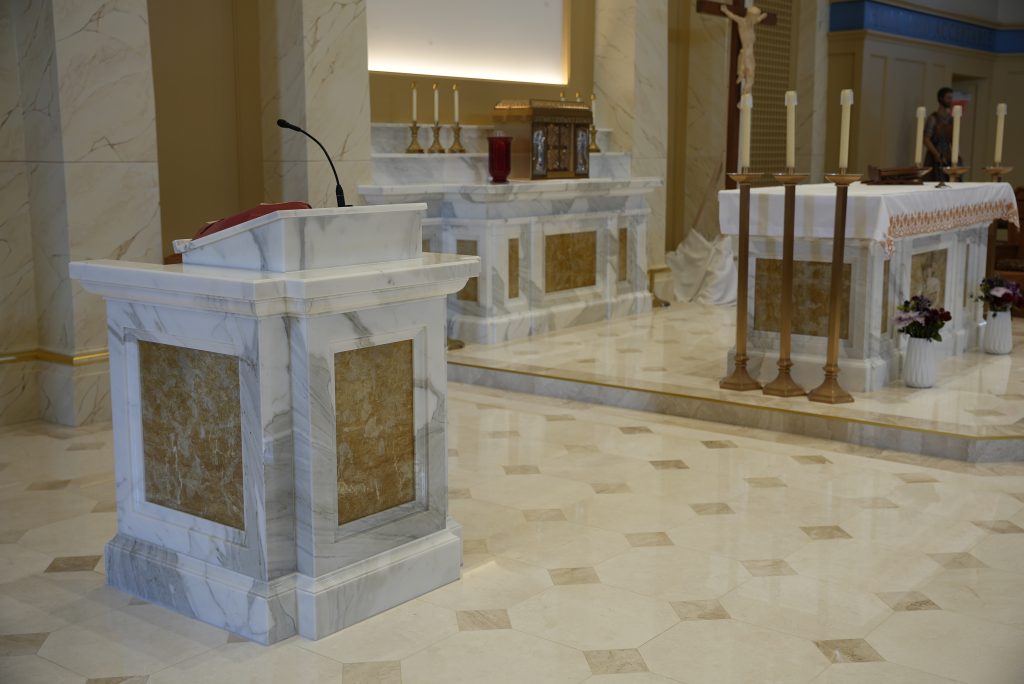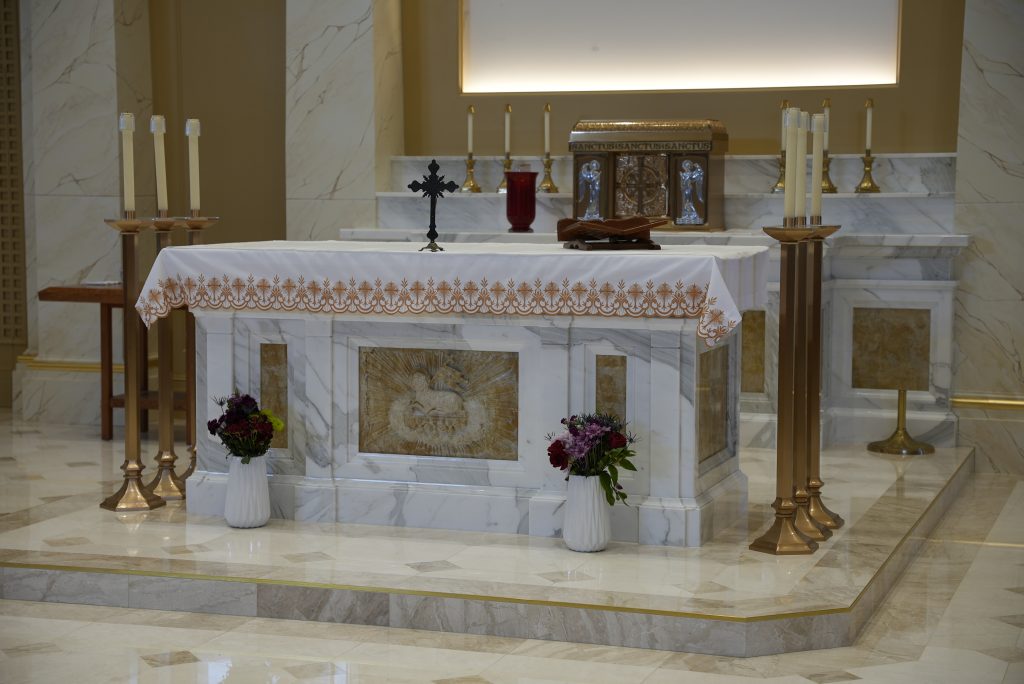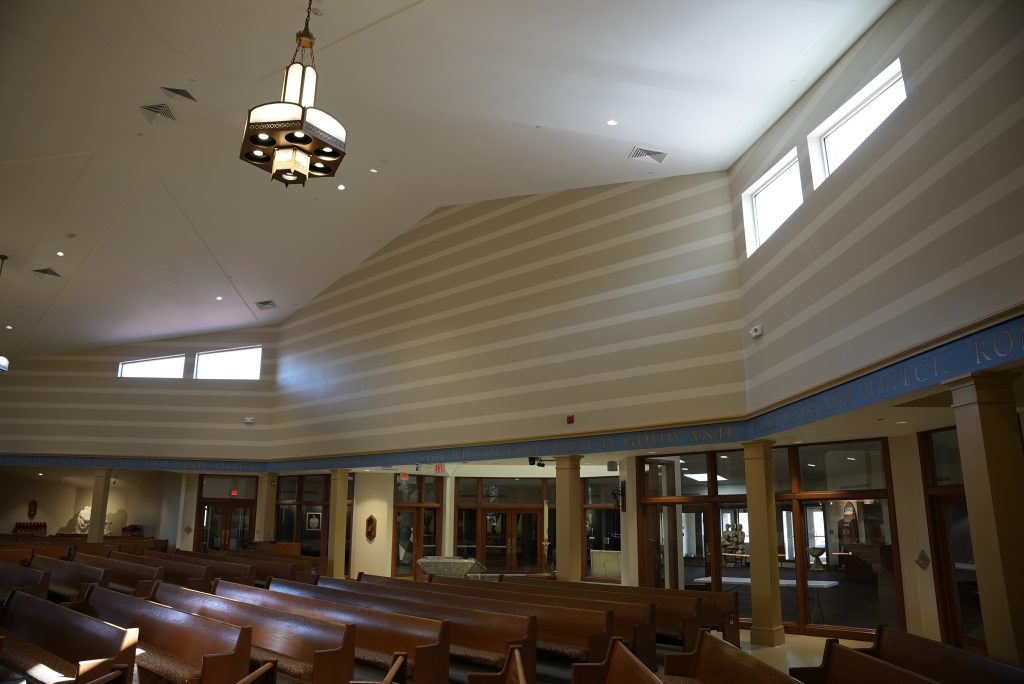March 26, 2024 // Diocese
‘A Physical Manifestation of Heaven on Earth’
Renovations at St. Elizabeth Ann Seton Parish Near Completion
Nearly a decade after it began as a mere dream, an extensive project at St. Elizabeth Ann Seton Parish in Fort Wayne is finally nearing its conclusion.
The parish is close to completing major church renovations that began last July but were first envisioned long before. Plans to renovate the church and expand the school were originally made under former Pastor Father Jim Shafer, and a capital campaign helped raise the necessary money for both projects. However, when the decision was made to expand the school to a full kindergarten through eighth grade model, funds were redirected to the school, leaving designs for a church renovation unfulfilled.
“So, we had old designs as a good starting point that were already presented to the parish – people had seen them, people had donated for that purpose,” said Father Terry Coonan, Pastor of St. Elizabeth Ann Seton. “And because of that, there was significant desire to see some of that come to fruition. It was, in a sense, a very easy thing for the parish to get on board with.”
When Father Coonan arrived as pastor in 2021, he was informed of the previous plans but initially focused on smaller changes – such as moving the tabernacle to the center of the sanctuary and aligning the crucifix with the window behind the altar – before opening dialogue with parishioners who were architects. One of these was Mike Niezer with Design Collaborative, an architecture and engineering design firm in Fort Wayne. According to Niezer, these early conversations revealed not only Father Coonan’s ideas and functional requirements for the church but also his underlying desires for the project and what he ultimately wished to achieve.
“Father Terry talked fundamentally, from Day 1, driving home the idea that the church needs to be a space where people can come and connect with the divine nature, and the physical embodiment of that is what we experience in Mass,” Niezer said. “So, when we talked about the architecture, we talked about how that can be a physical manifestation of heaven on earth – a space that’s worthy of the sacredness of what’s actually taking place. We started there before we started anything else, and the architecture was born out of that.”
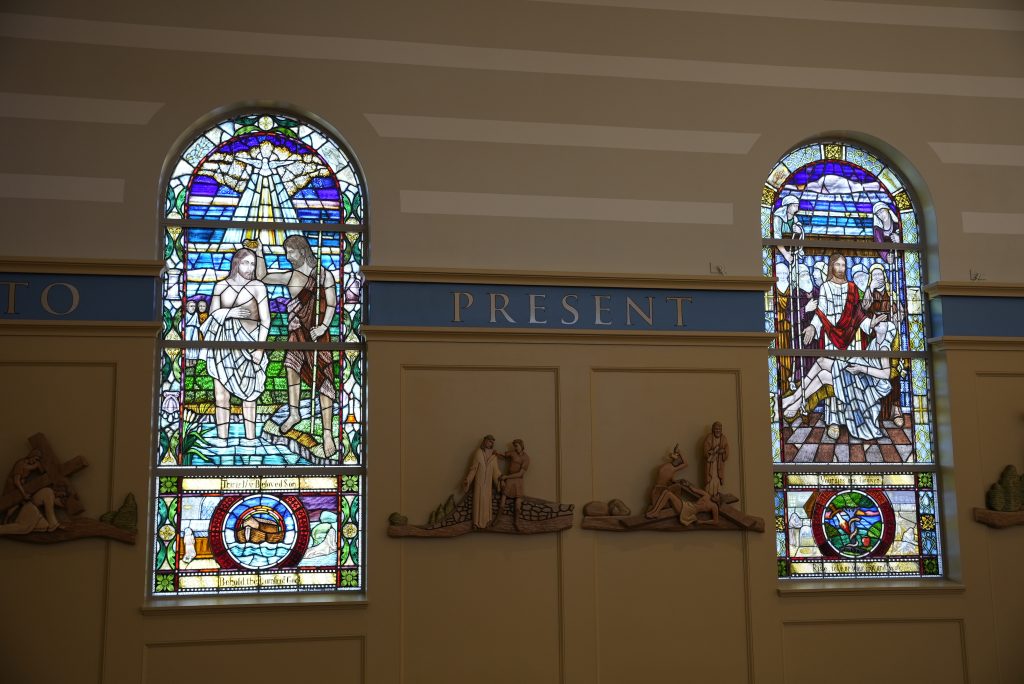
Some of the first stained-glass windows to be completed reflects an event from the life of Christ and a corresponding event in St. Elizabeth Ann Seton’s story.
Design Collaborative was a natural fit, thanks to its previous involvement in diocesan projects such as the University of Saint Francis Chapel, the Queen of All Saints Chapel at Bishop Dwenger High School, and St. Patrick Church in Ligonier. Niezer helped conduct things from a high level and was aided by Phil Breckler, who brought extensive experience with Catholic liturgical work to the project. They partnered with fellow parishioner Tim Schenkel of Schenkel Construction, who served as project manager after previously overseeing work at a handful of Fort Wayne parishes, including St. Charles Borromeo, St. John the Baptist, the Oratory of St. Mary Magdalene at St. Vincent de Paul, and Divine Mercy Funeral Home. “There’s very few parishes that we haven’t done some work at, whether it’s replacing a door or remodeling a church,” Schenkel said. However, he admitted it “makes it extra special when you get to work on your home parish.”
While Father Coonan spearheaded the effort on the parish side, he had discussed many aspects of it with previous Parochial Vicars Father Stephen Felichichia and Father Luke Okoye during their assignments at the parish, and he would occasionally “go shopping” for new items with current Parochial Vicar Father Jake Schneider. He also consulted his parish council on multiple occasions and leaned on the experience of parishioner Ron Glotzbach, who served as project manager 10 years ago. This support, along with significant parish savings and individual contributions, enabled Father Coonan to give the renovations the green light without another capital campaign.
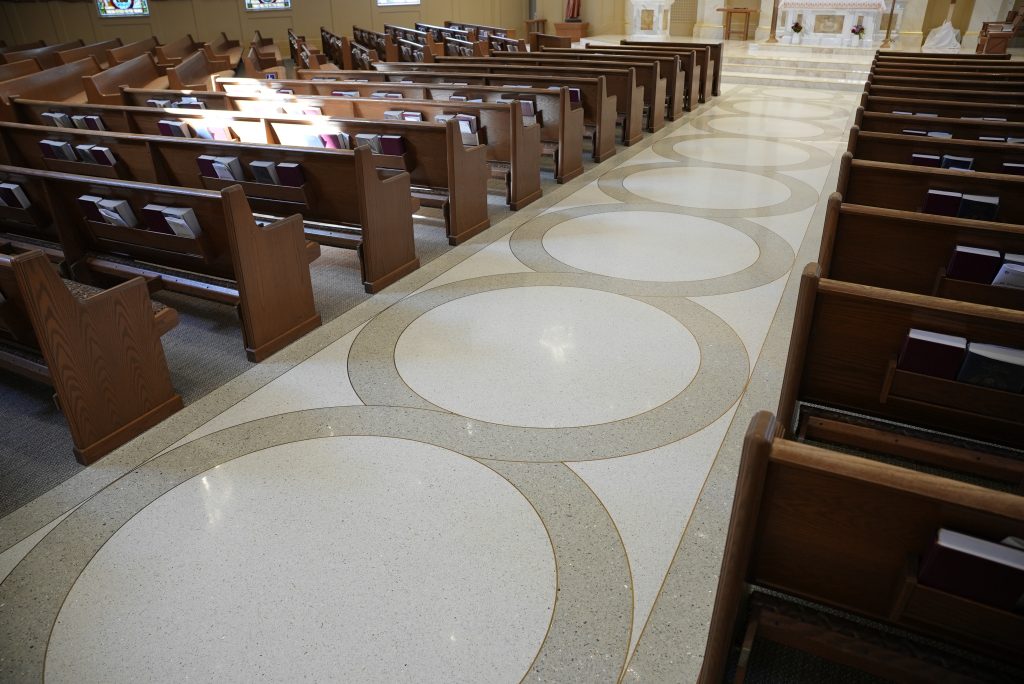
Seven interlocking circles line the Terrazzo floor from the baptismal font to the alter, signifying the seven sacraments.
Work began last July as weekday Masses were moved to the Divine Mercy Eucharistic Chapel to allow for construction Monday through Friday. Meanwhile, a temporary wall was constructed in front of the sanctuary to separate the demolition and restructuring from the rest of the church. This was the norm for four months until All Saints’ Day, when weekend and school Masses were moved to the gymnasium to give the construction workers free reign in the church. In the six weeks leading up to Christmas, every inch of the floor was redone, and marble was installed in the sanctuary, as Masses alternated between the gym, the chapel, and the parish hall.
“It was a significant amount of work for Father Jake and myself, and others, kind of designing, setting up all these sanctuaries again and again and again,” admitted Father Coonan. “All the extra hours of setup and takedown were definitely the hardest things.”
However, when parishioners returned to the church for the Christmas liturgies, they were greeted with tangible progress. One of the most noticeable additions was a Scripture passage from Romans 12:1-2 that stretches around the church on a blue banner: “I appeal to you therefore, brothers, by the mercies of God, to present your bodies as a living sacrifice, holy and acceptable to God, which is your spiritual worship. Do not be conformed to this world, but be transformed by the renewal of your mind, that by testing you may discern what is the will of God, what is good and acceptable and perfect.” Father Coonan selected this passage not only because of its size and fit but also because it captures the essence of offering of oneself as a sacrifice at Mass.
“Day by day, it’s going to be a constant reminder for us of what we’re supposed to do when we’re here,” Father Coonan said, “but then what our whole life is meant to be, too.”
Other enhancements were additional windows cut into the top of the rear walls to add natural light, new hanging light fixtures, frontals for the first row of pews, an updated sound system, and a new altar and ambo that were dedicated by Bishop Rhoades on Saturday, March 9. In addition, custom-made stained-glass windows display both events from the life of Christ and corresponding parts of St. Elizabeth Ann Seton’s life.
“We can use her story to represent and remind all of us that the story of our lives is, in a sense, a sacred story,” Father Coonan said. “It’s meant to be enveloped and drawn into the great story [of Christ], so that’s what we’re doing with these windows.”
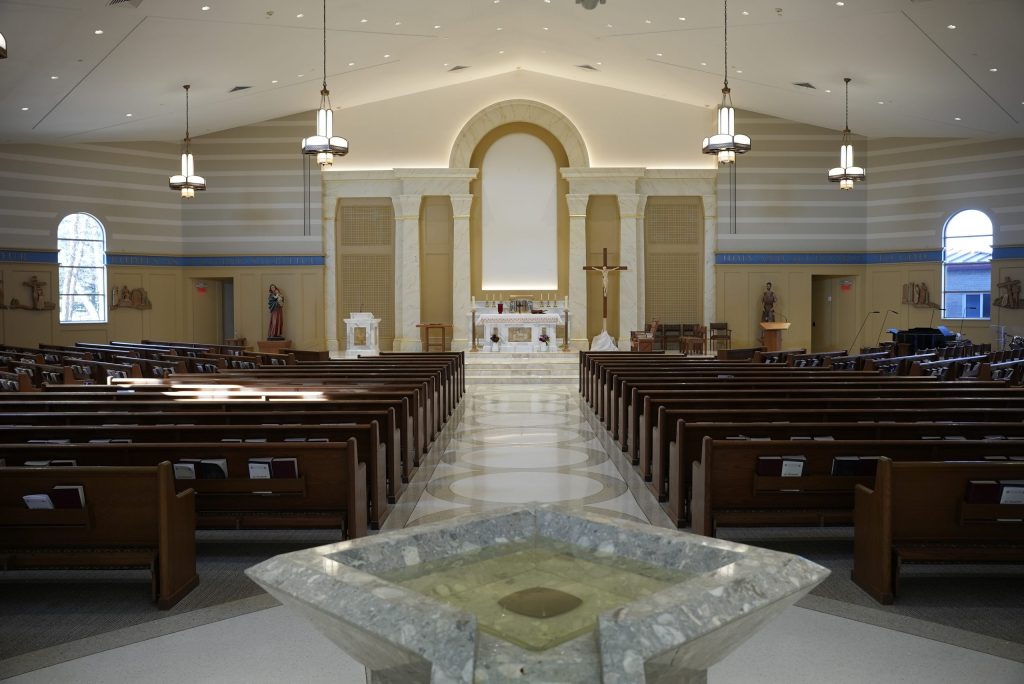
This is a view down the main aisle of St. Elizabeth Ann Seton, from the baptismal font to the altar.
Even the more subtle aspects of the church’s design are saturated with meaning, and the materials chosen reflect the dignity of the spaces in which they are used. For instance, the floor of the main aisle leading from the baptismal font to the altar is terrazzo, compared to the vinyl tile used throughout the rest of the church, to highlight the importance of these two locations. “The story of our salvation is lived out between the font and the altar,” reflected Father Coonan, referencing our baptism and our journey to eternal life. “The sanctuary represents heaven, and Christ comes down from heaven to encounter us. And when we go to Communion, he comes out of heaven to meet us there at the edge.”
Many elements of the new designs also hold special significance for the church’s patroness. The striped pattern on the walls and the columns behind the altar are reminiscent of the National Shrine of St. Elizabeth Ann Seton in Emmitsburg, Maryland, where the saint is buried. Likewise, the seven interlocking circles down the main aisle, which represent the seven sacraments, were inspired by a similar pattern at the Basilica of St. John Lateran in Rome, where St. Elizabeth Ann Seton likely visited while in Italy.
The final steps are the installation of the remaining stained-glass windows and the painting that is being completed in studio for the wall behind the altar: a depiction of the crucifixion that blends into a heavenly scene of the Communion of Saints above.
Even before the finishing touches are added, Niezer expressed feeling “really personally fulfilled” by the progress, while the transformation has been powerful for Schenkel and has brought out the best in his team. “Base trim in office buildings gets pretty repetitive. These unique opportunities, whenever you get to do something special, gets you really excited,” said Schenkel, noting the efforts of more than 100 individuals who had been involved in the construction. “It stirs something up inside of them and pushes their talents.”
While the renovations have also elicited overwhelmingly positive reactions from parishioners – many remarking that the church feels bigger or brighter – Father Coonan acknowledged that “change is hard” and that departing from the familiar will impact people, especially those who have received sacraments or experienced weddings or funerals in the church. However, Father Coonan said, he hopes the new design will give them a greater sense of peace and draw them closer to the source of all beauty: God Himself.
“The main goal is that this helps us to worship better,” Father Coonan said. “That peace, and that ability to feel relaxed here, and that sense of wonder and awe – all of that is to support truly worshiping God. The way the architecture is meant to draw the eye and the attention toward the sanctuary, and later, the altar and tabernacle, so that our attention is there and we’re able to worship God well – that’s what I want above all: that people can reflect and meditate on the story of salvation, on the life of Christ, and offer themselves to the Lord.”
Niezer, who grew up going to St. Elizabeth Ann Seton and now has kids attending the school, has already experienced this enhanced sense of worship firsthand with his family.
“We go to Mass every Sunday, and it’s been a really positive change for us for our experience during Mass,” Niezer said. “I can think of Sundays, when – if it’s a bright and sunny day – rays of light come though [the new windows] and hit the altar and change the experience in front of the church sanctuary. It creates a heightened feel of the significance of what’s happening up there.”
The best news. Delivered to your inbox.
Subscribe to our mailing list today.







